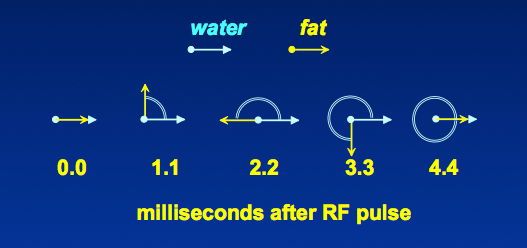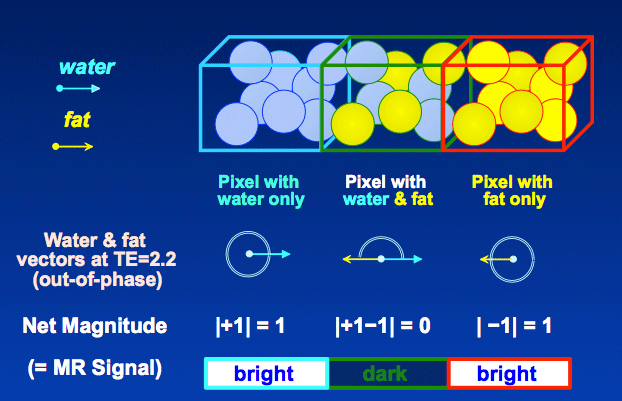|
The chemical shift artifact of the second kind is sometimes known as the India Ink or black line artifact because it looks like organs and muscle bundles have been outlined with a black pen. The line does not correspond to a true anatomic structure, but results from destructive interference of signals within boundary pixels that contain both water and fat. For this reason it is sometimes often called the phase cancellation artifact. Examples in the spine, thigh, and abdomen are shown.
|
This form of chemical shift artifact occurs exclusively in gradient echo imaging (unlike chemical shift artifact of the first kind that is seen in spin echo imaging). Additionally, since this 2nd type of artifact is due to a phase-cancellation effect, it is not limited to the frequency-encode direction (as is the chemical-shift artifact of the first kind), but may be seen in all pixels along a fat-water interface.
|
In spin-echo imaging, the signals between water and fat come back into phase at the center of every echo (even though they differ in frequency and are spatially misregistered). In gradient-echo imaging, however, water and fat protons do not generally come into phase coherence at the center of the echo (since the GRE sequence lacks the 180° refocusing pulse, which accomplishes this task in SE imaging). In a GRE sequence, therefore, fat and water protons go in and out of phase with one another as a function of echo time (TE). At 1.5 T the period of this alternation is about 1/(225 Hz) or 4.4 msec. Therefore, at TE = 2.2, 6.6, 11.0, and 15.4 msec, etc., fat and water fall out of phase with one another in gradient-echo images at 1.5 T. GRE images acquired with echo times near these "special values" demonstrate chemical-shift artifacts of the second kind.
|
The origin of the phase-cancellation effect and production of the "black line" is shown in the diagram above. Here a boundary pixel is illustrated that contains equal numbers of fat and water protons imaged at the out-of-phase time of TE = 2.2 msec. Because the water and fat signals are out of phase, they cancel each other producing zero net magnitude and hence a signal void. Pure fat and pure water pixels have no such cancellation, and because magnitude image reconstruction is displayed, both are rendered bright in the final image. Thus the pure water and fat pixels are separated by a dark boundary at their interface.
Advanced Discussion (show/hide)»
No supplementary material yet. Check back soon.
References
Wehrli FW, Perkins TG, Shimakawa A, Roberts F. Chemical shift-induced amplitude modulations in images obtained with gradient refocusing. Magn Reson Imaging 1987; 5:157-8.
Wehrli FW, Perkins TG, Shimakawa A, Roberts F. Chemical shift-induced amplitude modulations in images obtained with gradient refocusing. Magn Reson Imaging 1987; 5:157-8.
Related Questions
What is a chemical-shift artifact?
What is a chemical-shift artifact?





